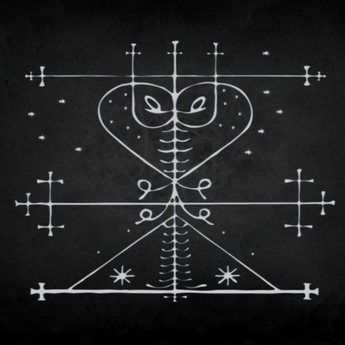Deity
Loa: Maman Brigitte
MAMAN BRIGITTE
Loa of death and Guardian of Graves.
Other names:
- Gran Brigitte
Patronage:
- Death, gravestones, cemeteries, obscenities, passion, souls of deceased relatives, justice, fertility, women.
Family
- She is the wife of Baron Samedi.
Offerings:
She is symbolized by a black rooster, and her sacred trees are the elm and the weeping willow.
Her ceremonial colors are black and purple.
Her favorite offering is pepper-infused rum, black roosters and candles.
Veve:

Mythology:
Brigitte is the powerful cemetery lwa and is given offerings of pepper-infused rum. She protects tombstones and graves and indeed in her work is done on the first woman buried in the cemetery who is identified as Maman Brigitte. In Haiti the first female grave in the cemetery is marked with a stone cross and belongs to Maman Brigitte.
Like her husband Baron Samedi, Maman Brigitte rules the cemetery and the dead. She is called upon in matters involving healing and to punish the wicked. She is the ultimate judge and can be called upon to inflict punitive retribution on those who harm her devotees. When people are suffering from chronic or terminal illnesses, she can either ease their suffering or intervene on their behalf to heal them. Some devotees also call upon her to heal sexually-transmitted diseases.
Maman Brigitte is unusual among the lwa in that she is occasionally depicted as fair-skinned and with light hair, suggesting the European roots of her name. In other syncretic practices Maman Brigitte is depicted as Mary Magdalene.
Source:
- THE TOP ELEVEN DEITIES IN VOODOO MYTHOLOGY
- http://voodoo.101projects101days.com/loa/brigitte/
- http://readersandrootworkers.org/wiki/Maman_Brigitte
- Leah Gordon (1985), The Book of Vodou
Questions?
What is a Veve?
A Veve (spelled Vèvè or Vevè) is a religious symbol commonly used in different branches of voodoo throughout the African diaspora such as Voodoo and is different than the petipembas used in Palo or ponto riscados used in Quimbanda since they are all separate African religions. It acts as a “beacon” for the Loa, and will serve as a loa’s representation during rituals.


